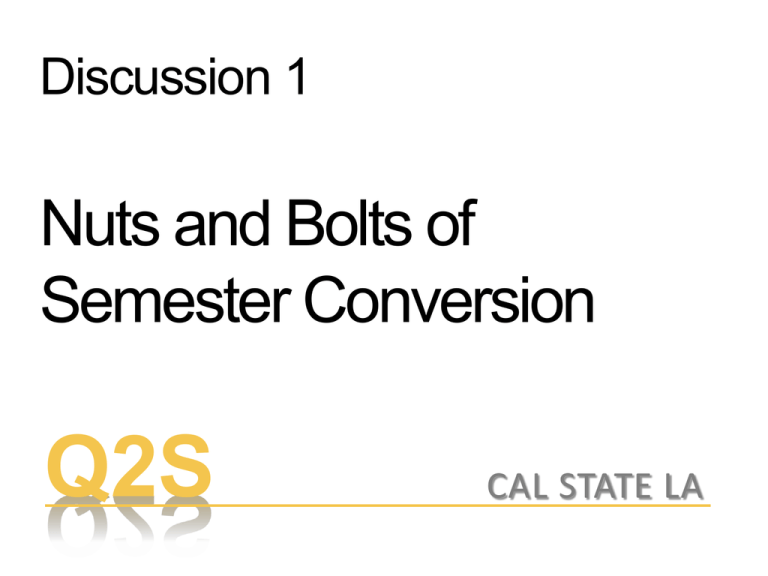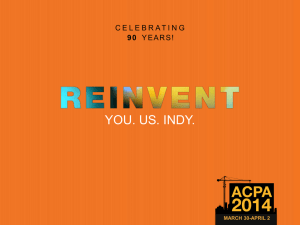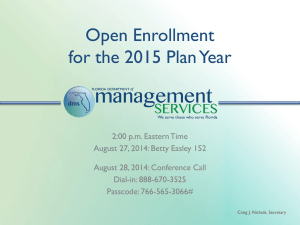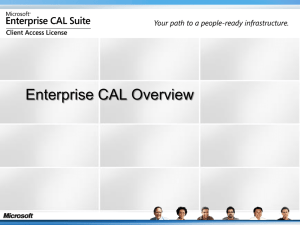Fall Faculty Day, Discussion 1, The Nuts and Bolts of Semester
advertisement

Discussion 1 Nuts and Bolts of Semester Conversion Q2S CAL STATE LA Zen and the Art of Semester Conversion Cheryl Ney, Associate Vice President for Academic Affairs Q2S CAL STATE LA http://eigenblogger.com/2010/09/10/post1594/ Q2S CAL STATE LA Q2S CAL STATE LA Q2S CAL STATE LA Getting Started with Semester Conversion Rennie Schoepflin, Director of Semester Conversion Q2S CAL STATE LA Semester Conversion: Organizational and Committee Structure Executive Sponsors-University President and Provost Semester Conversion Project Director University Semester Conversion Committee Subcommittees of University Semester Conversion Committee 1. Student Advising 2. Enrollment Services 3. Information Technology 4. CSU Cross-Campus 5. Administrative Services 6. Communications Curricular review will use existing committees within academic governance at the department, college, and institutional levels Q2S CAL STATE LA Curriculum Conversion and Advisement: I. Operational Recommendations for submission, review, and approval of proposals for curriculum conversion II. E-advising Margaret Garcia, Associate Professor, Division of Special Education and Counseling Steven Jones, Associate Dean for Undergraduate Studies Parviz Partow-Navid, Associate Director for Semester Conversion Q2S CAL STATE LA Operational Recommendations for submission, review, and approval of proposals for curriculum conversion (based on Task Force recommendations) Q2S CAL STATE LA Online Curriculum Proposal and Review: • Develop and utilize SharePoint for electronic curriculum review process and tracking with proposals uploaded as Word documents; • Make most recently approved course proposals available as scanned documents in the SharePoint archive (prior proposals will be available upon request from college offices or from the Office of Undergraduate Studies); • Make all course proposals submitted for semester conversion available as read only documents for all faculty and staff; • Cut and paste existing programs in the e-catalog program into program modification proposals and use Track Changes to indicate proposed modifications. Training: • During Fall 2013, make available to faculty training in developing proposals and using the SharePoint website. Q2S CAL STATE LA Objections: • Only Department Chairs, Associate Deans, and College EPC will be authorized to post formal objections through the SharePoint website. Q2S CAL STATE LA Timeline: • Since curriculum conversion must be completed by May 2015 to be available Fall Quarter 2016, course and program proposals should be submitted by the colleges to the Office of Undergraduate Studies for University review no later than the start of Fall Quarter, 2014. Q2S CAL STATE LA Committee Structure: • Use existing curriculum review process with appropriate support to compensate the faculty members serving on college and University committees to review the course and program modification proposals; committees would include six five-member college curriculum committees, three University committees (GES, Undergraduate Curriculum, and Graduate curriculum) with six college representatives on each committee, and EPC . • Increases number of units taken per student. • Assists with identifying Course Demand with real time analysis on which courses are being searched for the most. • Helps students’ graduate on-time by eliminating "filler" classes with fast, easy schedule planning. • Advisors have more time assisting students decide which classes to take, not the specific times to take them. • Eliminates laborious schedule generation for special student cohorts like incoming freshmen and athletes. • http://collegescheduler.com/benefits.html • http://www.collegescheduler.com/helpvideo.html?recipient=cney@cslanet.calstatela.edu California State University, Los Angeles (CSULA) has elected to use Ad Astra scheduling software for scheduling of academic and event activities. One primary goal for CSULA is to enhance course access for students in alignment with campus resources. Ad Astra scheduling module assists in developing course schedules that optimizes the availability of faculty and space for the benefit of students. Accessing Ad Astra • Please fill out the Student Administration Account request document located at the Information Technology Services forms page (http://www.calstatela.edu/its/forms/) and submit the form to the University Registrar, Enrollment Services office, ADM 401. • Use the link below to access the Ad Astra production: http://adastra.calstatela.edu Platinum analytics software helps to improve course availability, retention, and graduation rate by: • Evaluating course offerings along with student demand to identify section addition and reduction candidates • Providing data to refine course offering times to optimize students’ course access • Helping on-time completion of students' degree requirements through the interactive Academic Planner What-if Analysis Advisor Notes GE Revision and the Faculty Cheryl Koos, Chair GE Revision Committee and GE Subcommittee Q2S CAL STATE LA Institutional Learning Outcomes • Knowledge: Mastery of Content and Processes of Inquiry • Proficiency: Intellectual Skills • Place and Community: Urban and Global Mission • Transformation: Integrative Learning Q2S CAL STATE LA Proposed General Education Learning Outcomes Knowledge: Mastery of Content and Processes of Inquiry Students who complete GE: • Demonstrate understanding of the physical and natural world. • Demonstrate understanding of contemporary events within political and historical contexts. • Demonstrate understanding of the diversity of cultures and communities in the United States and abroad. • Demonstrate understanding of ethics and social inequalities. • Demonstrate understanding of a range of disciplinary ways of knowing GE Learning Outcomes (cont.) Proficiency: Intellectual Skills Students who complete GE: • Demonstrate civic literacy that would enable them to participate effectively in a democratic society. • Use inquiry processes, including quantitative and qualitative reasoning and critical and creative thinking, to engage with contemporary and enduring questions. • Find, use, evaluate and process information in order to engage in complex decision-making and problem solving. • Read, speak and write effectively. • Demonstrate an ability to work collaboratively. GE Learning Outcomes (cont.) Engagement: Local and Global Communities Students who complete GE: • Demonstrate the capacity to engage meaningfully with diverse communities. • Demonstrate understanding of how individuals affect society and the environment. • Demonstrate the capacity to make well informed, ethical, and socially responsible decisions. • Demonstrate understanding of the interconnectedness of local and global communities. • Demonstrate literacy in the perspectives and needs of individuals and groups. GE Learning Outcomes (cont.) Transformation: Integrative Learning Students who complete GE: • Integrate academic learning with life through project-based experiences. • Integrate their knowledge, skills and experience to address complex, enduring, and emerging issues. Fall 2013 GE Revision Committee Agenda • Complete draft of new GE Framework Proposal • Hold town hall meetings on GE Framework draft • Introduce GE Framework and Learning Outcomes to the Academic Senate The Faculty and GE • How can the faculty participate in the process? • PARTICIPATE CONSTRUCTIVELY • BE ENGAGED IN THE PROCESS • ENCOURAGE COLLEAGUES TO BE ENGAGED IN THE PROCESS Faculty Workload: During and After Semester Conversion Philip LaPolt, Assistant Vice President for Academic Personnel Q2S CAL STATE LA Faculty Workload: During and After Semester Conversion Q2S CAL STATE LA What’s My Workload? • Typical faculty workload is 12 units, plus 3 units of indirect instructional activity. • Under quarters, 12 units = 12 hrs per week x 10 weeks = 120 instructional hrs (x 3 = 360 hours per year) • Under semesters, 12 units = 12 hrs per week x 15 weeks = 180 instructional hrs (x 2 = 360 hours per year) • The academic calendar is workload neutral. Q2S CAL STATE LA Then what’s different? • Quarters: three courses x four hours per week (four-unit courses) • Semesters: four courses x three hours per week (three-unit courses) 4x3=3x4 • Per year, nine courses typically taught under quarters, eight courses under semesters Q2S CAL STATE LA However…. • Neither the Collective Bargaining Agreement (CBA) nor University policy define the workload of faculty, in terms of WTUs. • CBA: “faculty shall not be assigned an excessive number of contact hours, assume an excessive student load, or be assigned an unreasonable workload or schedule.” • Flexibility in faculty assignments is therefore possible, within budgetary, scheduling, and enrollment constraints. Q2S CAL STATE LA Achieving Flexibility Ways of reducing the numbers of WTUs assigned to faculty could include…… - increasing average class size and student/faculty ratio; - adding more large lecture classes and more very large lecture classes with TA and GA support; - additional external grant, foundation, or endowment funding of release time; and - additional general funds to supplement the instructional budget. Q2S CAL STATE LA Workload During Conversion • Faculty will receive assigned time to do the work of converting programs and curriculum. • Assigned time may be used during academic quarters (classes off) and during periods between quarters and in summer (additional salary). Q2S CAL STATE LA Basis of Assigned Time • Assigned time will be based on the amount of work to be done in the department. • Basic factors considered: – Numbers of undergraduate, graduate, and credential programs – Numbers of General Education and service courses offered Q2S CAL STATE LA Basis of Assigned Time • Additional factors considered: – Conversion-Plus: transformation of programs and curricula – Early completion of department approvals – Other rationale for additional assigned time Q2S CAL STATE LA Discussion 1 Nuts and Bolts of Semester Conversion Questions? Q2S CAL STATE LA






